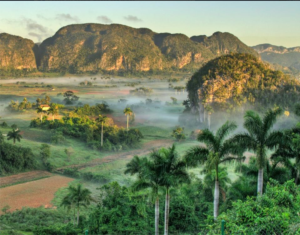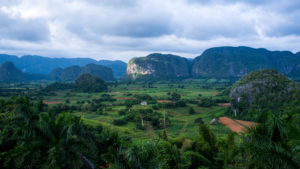 EL VALLE DE VIÑALES, UN REAL Y NATURAL MONUMENTO NACIONAL CUBANO.
EL VALLE DE VIÑALES, UN REAL Y NATURAL MONUMENTO NACIONAL CUBANO.
El valle de Viñales es una depresión kárstica en Cuba. El valle tiene una superficie de 132 km2 (51 millas cuadradas) y se encuentra en la Sierra de los Órganos (parte de la cordillera Guaniguanico), justo al norte de Viñales en la provincia de Pinar del Río. El Valle de Viñales es un accidente geográfico que tiene para sí toda la gama de colores con una belleza natural magestuosa.
En el período Jurásico este territorio estuvo compuesto por mar, deltas y llanuras del desaparecido continente, teniendo como elementos básicos de la geología local las piedras calizas, donde se encuentran abundantes fósiles de ammonites, peces y exquistos fósiles del dinosaurio terrestre “Diplodocus” y el reptil marino “Ichthyosaurus”.
El tabaco y otros cultivos se cultivan en el fondo del valle, principalmente mediante técnicas agrícolas tradicionales. Muchas cuevas salpican las colinas circundantes (Cueva del Indio, Cueva de José Miguel).
Los llamativos acantilados de piedra caliza que se elevan como islas desde el fondo del valle se llaman mogotes. Pueden tener hasta 300 m de altura. Estos mogotes se parecen a una gran diversidad de formas porque solo son comparables con los ubicados en China y la península de Malaca.
En el valle, hay otras elevaciones, como Alturas de Pizarras, que están formadas por una variedad de rocas, las más antiguas que existen en todo el país y también en el área del Caribe.
Como sello distintivo del lugar está el Mural de la Prehistoria, en el propio Valle, obra del pintor cubano Leovigildo González, ya fallecido, que recrea las distintas etapas evolutivas de la humanidad, sobre una pared de uno de los mogotes.
Conservación
Muchas plantas y animales endémicos son específicos de este valle. La flora encontrada en la región incluye Bombax emarginatum, palma de montaña (Gaussia princeps), Ekmanianthe actinophilla y Microcycas calocoma. La fauna incluye el colibrí (Mellisuga helenae, zunzún), el trogon cubano (Priotelus temnurus), el tody cubano (Todus multicolor), el solitario cubano (Myadestes elisabeth) y el chinche cubano (Tiaris canorus).
La complicidad entre la naturaleza y el silencio se halla por todas partes, con su río subterráneo, el Rancho San Vicente y el fabuloso Mirador de Los Jazmines.
El poblado de Viñales, ubicado en el valle, conserva el tradicional escenario de un asentamiento de agricultores, representado por su calle principal, galerías de columnas a sus lados y casas de tejas rojas que favorecen sus condiciones climáticas, dándole una apariencia singular y agradable.
EL Valle de Viñales es un real Monumento Nacional y la Unesco le otorgó también la categoría de Paisaje Cultural de la Humanidad.
 THE VALLE DE VIÑALES, REAL, AND NATURAL CUBAN NATIONAL MONUMENT.
THE VALLE DE VIÑALES, REAL, AND NATURAL CUBAN NATIONAL MONUMENT.
The Viñales valley is a karst depression in Cuba. The valley covers an area of 132 km2 (51 square miles) and is located in the Sierra de Los Órganos (part of the Guaniguanico mountain range), just north of Viñales in the province of Pinar del Río. The Viñales Valley is a geographical accident that has for itself the full range of colors with a natural beauty majestic.
In the Jurassic period this territory was composed of the sea, deltas, and plains of the disappeared continent, having limestone stones as basic elements of the local geology, where there are abundant fossils of ammonites, fish and exquisite fossils of the terrestrial dinosaur “Diplodocus” and the marine reptile “Ichthyosaurus”.
Tobacco and other crops are grown at the bottom of the valley, mainly through traditional agricultural techniques. Many caves dot the surrounding hills (Cueva del Indio, Cave of José Miguel).
The striking limestone cliffs that rise like islands from the bottom of the valley are called mogotes. They can be up to 300 m high. These mogotes resemble a great diversity of forms because they are only comparable with those located in China and the Malacca peninsula.
In the valley, there are other elevations, such as Pizarras Heights, which are formed by a variety of rocks, the oldest that exists throughout the country and also in the Caribbean area.
As a hallmark of the place is the Mural of Prehistory, in the Valley itself, the work of Cuban painter Leovigildo González, already deceased, who recreates the different evolutionary stages of humanity, on a wall of one of the mogotes.
Conservation
Many endemic plants and animals are specific to this valley. The flora found in the region includes Bombax emarginatum, mountain palm (Gaussia princeps), Ekmanianthe actinophilla and Microcycas calocoma. The fauna includes the hummingbird (Mellisuga helenae, zunzún), the Cuban trogon (Priotelus temnurus), the Cuban tody (Todus multicolor), the Cuban solitaire (Myadestes elisabeth) and the Cuban bed bug (Tiaris canorus).
The complicity between nature and silence is everywhere, with its underground river, Rancho San Vicente and the fabulous Mirador de Los Jazmines.
The town of Viñales, located in the valley, preserves the traditional setting of a farmers’ settlement, represented by its main street, column galleries on its sides and red-tiled houses that favor its climatic conditions, giving it a unique and pleasant appearance.
The Viñales Valley is a real National Monument and Unesco also awarded in the category of Cultural Landscape of Humanity.
Agencies/Wiki/ RHC/ Maria Calvo/ Internte Photos/ Arnoldo Varona/ www.TheCubanHistory.com
THE CUBAN HISTORY, HOLLYWOOD.









